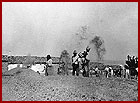
The distribution of large properties did not solve the sustenance problem of farmers. In the Balkans the abrupt rise in population (due to the beneficial intervention of medicine, which arrived with a delay) inflated continuously the classes of underemployed and unemployed in the primary sector of production. During the interwar period in the Greek country there was excess agricultural population, which could no be easily absorbed in agricultural production through the then-existing economic and social structures.
In Greece, where the annual average rise in population during the interwar period was 1,93%, a percentage of 50,3% of the agricultural population did not participate in the production process. In Yugoslavia on the other hand, where the average rise in population was 1,43%,  the percentage of non-contribution of farmers reached 61,5%. As the members of agricultural families multiplied, land was divided in all the smaller allotments. The low yield of allotments caused by the incapacity of small landowners to cover the expenses for the modernisation of their farming means, worsened by the incessant splitting of land. At the same time, the exportation of agricultural products was made more difficult due to protective tariffs imposed by European countries on imported goods. Besides, the countries that dominated the grain exports were unrivalled in the international market. To these difficulties were added the encumbrance of indirect taxes, the lack of sufficient credit organisations for farmers, the absence of social security and lastly the inability to emigrate to America, since the latter had restricted resolutely the emigrant influx. It is therefore obvious how difficult was the situation of the country people. the percentage of non-contribution of farmers reached 61,5%. As the members of agricultural families multiplied, land was divided in all the smaller allotments. The low yield of allotments caused by the incapacity of small landowners to cover the expenses for the modernisation of their farming means, worsened by the incessant splitting of land. At the same time, the exportation of agricultural products was made more difficult due to protective tariffs imposed by European countries on imported goods. Besides, the countries that dominated the grain exports were unrivalled in the international market. To these difficulties were added the encumbrance of indirect taxes, the lack of sufficient credit organisations for farmers, the absence of social security and lastly the inability to emigrate to America, since the latter had restricted resolutely the emigrant influx. It is therefore obvious how difficult was the situation of the country people.
|


